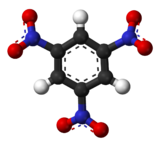1,3,5-Trinitrobenzene

| |

| |
| Names | |
|---|---|
| Preferred IUPAC name
1,3,5-Trinitrobenzene | |
| Other names
sym-Trinitrobenzene
| |
| Identifiers | |
3D model (JSmol)
|
|
| ChemSpider | |
| ECHA InfoCard | 100.002.502 |
PubChem CID
|
|
| UNII | |
| UN number | 0388 |
CompTox Dashboard (EPA)
|
|
| |
| Properties | |
| C6H3N3O6 | |
| Molar mass | 213.105 g·mol−1 |
| Density | 1.76 g/cm3 |
| Melting point | 123.2 °C (253.8 °F; 396.3 K) |
| Boiling point | 315 °C (599 °F; 588 K) |
| 330 mg/L | |
| -74.55·10−6 cm3/mol | |
| Hazards | |
| NFPA 704 (fire diamond) | 
2
4
4 |
Except where otherwise noted, data are given for materials in their standard state (at 25 °C [77 °F], 100 kPa). | |
| Infobox references | |
1,3,5-Trinitrobenzene is an organic compound with the formula C6H3(NO2)3. It is one of three trinitrated benzene-derivatives. A pale yellow solid, the compound is highly explosive.[2]
Explosive properties[]
1,3,5-Trinitrobenzene is a high explosive. It is moderately explosive in liquid form and extremely explosive in its dry powder form. It will detonate under strong shock. High temperatures, whether by sudden heating of any quantity, or by the accumulation of heat when large quantities are burning, will also cause detonation.
Synthesis and reactions[]
1,3,5-Trinitrobenzene is produced by decarboxylation of 2,4,6-trinitrobenzoic acid.[2]
1,3,5-Trinitrobenzene forms charge-transfer complexes with electron-rich arenes.
Reduction of 1,3,5-trinitrobenzene gives 1,3,5-triaminobenzene, a precursor to phloroglucinol.
Uses and applications[]
Trinitrobenzene is more explosive than TNT, but too expensive.[2] It is primarily used as a high explosive compound for commercial mining and military applications. It has also been used as a narrow-range pH indicator, an agent to vulcanize natural rubber, and a mediating agent to mediate the synthesis of other explosive compounds.[3]
Safety precautions[]
It is an extremely powerful oxidizing agent which may cause violent reaction with reducing materials.[4]
See also[]
- 1,2,3-Trinitrobenzene
- TNT equivalent
- RE factor
References[]
- ^ Record of 1,3,5-Trinitrobenzene in the GESTIS Substance Database of the Institute for Occupational Safety and Health
- ^ a b c Booth, Gerald (2005). "Nitro Compounds, Aromatic". Ullmann's Encyclopedia of Industrial Chemistry. Weinheim: Wiley-VCH. doi:10.1002/14356007.a17_411.
- ^ John Pike (1997-05-21). "Explosives – Nitroaromatics". Globalsecurity.org. Retrieved 2013-10-28.
- ^ Sax, N. I. and Lewis, R. J. Sr. (1987) Hazardous chemicals desk reference. Van Nostrand Reinhold, New York. p. 664.
- Nitrobenzenes
- Explosive chemicals